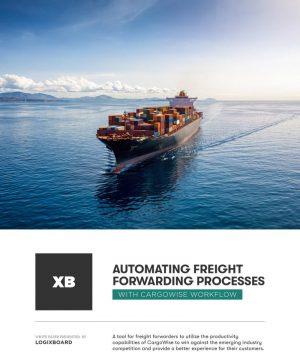Free CargoWise Workflow Training Guide
Automating Freight Forwarding Processes with CargoWise Workflow
A training tool for freight forwarders to utilize the productivity capabilities of CargoWise. Provided courtesy of the team at Logixboard to help logistics service providers provide a better experience for their customers and compete in an evolving market.
A training tool for freight forwarders to utilize the productivity capabilities of CargoWise. Provided courtesy of the team at Logixboard to help logistics service providers provide a better experience for their customers and compete in an evolving market.
In this guide, we will cover:
- 5 key CargoWise workflow features
- The importance of auditing your operation’s processes
- Using automation for maximum productivity

Inside This Free CargoWise Workflow Training Guide: Automating Freight Forwarding Processes
What are workflows?
Workflows are used to layout the defined processes of a forwarding operation within CargoWise. CargoWise workflow is an overarching tool with supplementary features consisting of tasks, milestones, and triggers that help teams organize, manage, and automate each step of a shipment. The five main CargoWise workflow features work together to support increased productivity in forwarding operations.
Workflow templates
CargoWise Workflow training can help forwarders set up templates to repeatedly use. The workflow templates are customizable, with the ability to alter the screen layout and add custom fields based on any additional needed tasks. Editing custom fields allows all saved templates to be updated to fit the precise needs of a project, leaving no excuse for not including as many details as possible. For example, if a forwarder is transporting a cargo order by ocean freight, they could save a workflow template based on certain ports, with milestones, tasks, and automatic triggers that would provide their customers and operations teams with insight into the whole journey. Alternatively, they could use this template as a foundation to create a new tem- plate to easily customize the workflow based on specific customer requirements.
CargoWise training: tasks
CargoWise Workflow training can help forwarders identify every task in an operation. Every miniscule step in a forwarding operation can be laid out in a workflow. When these steps are outlined as separate CargoWise tasks, they are assigned to an operations member (or other members who can complete them). Current tasks can be monitored to ensure that they are on track to be completed on time, and members are alerted when their tasks are due to be completed.
CargoWise training: milestones
CargoWise Workflow training can help be timely with milestones. The workflow feature then sorts steps and assigned tasks under CargoWise milestones. Milestones allow forwarders to mark key events of a shipment’s journey from the point of booking to the ultimate delivery. Milestones usually correspond with larger visibility data points shared with shippers (e.g., the initial cargo pickup date). These can be set as visible milestones for shippers/BCOs or provided for internal use only.
CargoWise training: exceptions
The CargoWise exception dashboard, which tracks current and historical overdue milestones, is vital for the internal assessment of operations and customer visibility of delays. The log of delays created by this dashboard can be helpful when communicating with shippers/BCOs on where delays have occurred, and the documentation of delays gives the operations team insight into how they can improve to avoid delays in the future. Exceptions are internally visible on all active, late milestones (with a red bell icon) to alert forwarders when something is behind schedule and needs action.
CargoWise training: triggers
After milestones (and the tasks to achieve them) are set up to match the procedures of a forwarding operation, CargoWise triggers can be used to add automation to the process. Triggers are automated functions set up in templates to alert different parties to tasks that are needed to complete a milestone, send documents to outside parties, gather data for software integrations, or send automatic correspondence to different parties when tasks are completed.
Auditing your process
Before forwarders can successfully integrate their processes into CargoWise workflows, they need to inspect every step of their process from start to finish. It’s important to get a holistic view of the process to see where inefficiencies occur and where CargoWise software can make a difference.
